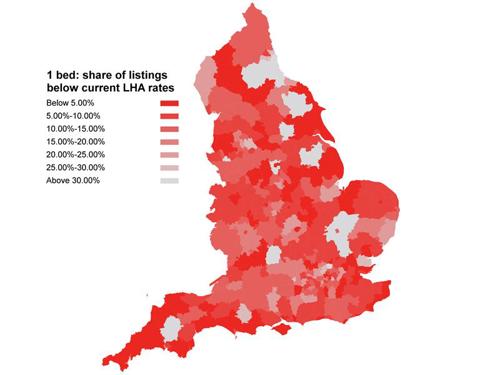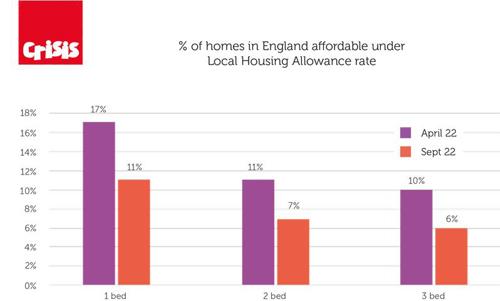Properties affordable on housing benefit have declined by a third in the last five months – down to just 8%
28.10.2022
Homeless charity Crisis warns the poorest households face a catastrophe as housing benefit shortfall grows
- Just 11% of one-bedroom properties across England are now affordable to people in receipt of housing benefit, down from 17% in April 2022
- Shortfalls between housing benefit and actual rents have increased by more than 40% in five months, on average
- Households face shortfalls of over £950 a year on average for one bed properties and even more for two and three beds – over £1,500 and £2,300 respectively
- Two in five private renters in England (1.7 million households) are reliant on housing benefit to cover the cost of their rent
The average gap between housing benefit rates and the actual cost of rents has grown by more than 40% in the last five months. This is compounding an already dire cost of living crisis for hundreds of thousands of low-income households, new research from Crisis, provided in partnership with Zoopla, has shown.
Just 11% of one-bedroom properties in England are now affordable on Local Housing Allowance, down from 17% in April 2022 when Crisis and Zoopla last conducted the analysis. The proportion of affordable two-bedroom properties has fallen to just 7% from 11%, and for three-beds now stands at a shocking 6%, down from 10% earlier this year.
The figures, the charity says, represent an increasingly desperate situation in which people receiving housing benefit are being totally priced out of the rental market and are at real risk of homelessness. This is extremely concerning given the scale of the problem, with one in three private renters reliant on housing benefit to cover the cost of their rent.

Figure 1: Share of listings below current Local Housing Allowance rates in England (Sept ’22)
London saw the most drastic fall, with affordability almost halving in the five months to September. The proportion of properties in the capital now available under Local Housing Allowance stands at an appallingly scarce rate of just 13%, 10%, and 11% for one-, two-, and three-bedroom properties respectively. In some boroughs, the picture is worse still. Hammersmith and Fulham have seen a decline in one-beds from 12% to just 5%. The analysis does not include the impact of the benefit cap, but this will likely make affordability even worse in London for many households.

Fig 2: Percentage of homes in England affordable under Local Housing Allowance rates, April and September '22
But the situation is similarly bleak across the country. In the North-East, the region with the highest proportion of one-bed properties available, still just a quarter of one-beds are affordable. London occupies second place at 13%, and in five of the nine regions (the East, East Midlands, South West, West Midlands, and Yorkshire and the Humber), fewer than one in 10 one-bed properties are affordable.
This widening gap between housing benefit rates and the true cost of rents mean that thousands are being pushed to the absolute limit on budgets that are already at breaking point. Previously, Crisis and Zoopla’s analysis of rising rents in the year up to April showed that shortfalls were more than double what the most recent Government figures, published this January, suggested. Now, this new research shows that, in fact, these shortfalls are between three and four times higher than the Government figures.
Low-income renters are being forced to find on average an additional £935 a year for a one-bed, £1,477 for a two-bed and £2,285 for a three-bed a year compared to Government figures of £313, £371 and £498, respectively.2
Housing benefit has been frozen since early 2020 and is based on rents from 2018-19. With rents rising at their fastest rate in 16 years and inflation soaring, Crisis is urging the Government to act with urgency and commit to increasing housing benefit in line with inflation in the upcoming Autumn Budget on November 17. The charity warns that failure to do so could push thousands more into homelessness.
Crisis is also deeply concerned for private renters’ abilities to be able to afford their already-inflated rents. More than two thirds of tenancies (68%) are under buy-to-let mortgages, meaning recent volatility and rising interest rates will see tenants being forced to bear the brunt of increasing costs.
Matt Downie, Crisis Chief Executive, said: “Current housing benefit levels are woefully behind rents, leaving people on the lowest incomes with drastically fewer options of finding a home. Homelessness is becoming a very worrying, and real prospect for families up and down the country.
“What’s more, housing benefit isn’t included in the Government’s commitment to uprate benefits – which we’re still yet to see if they will deliver on. Despite being most people’s biggest expense, these colossal rents are being ignored. The fact that affordability has deteriorated so drastically in just five months shows the pressing need for benefits to increase in line with real world costs – and just how punishing it is to freeze Local Housing Allowance rates for even a short period of time.
“Without urgent action we face the bleakest of winters. The new Prime Minister and the Chancellor have a choice: increase housing benefit or make thousands of people homeless. There's only one option if we are to avoid the misery and devastation of mass-homelessness."
